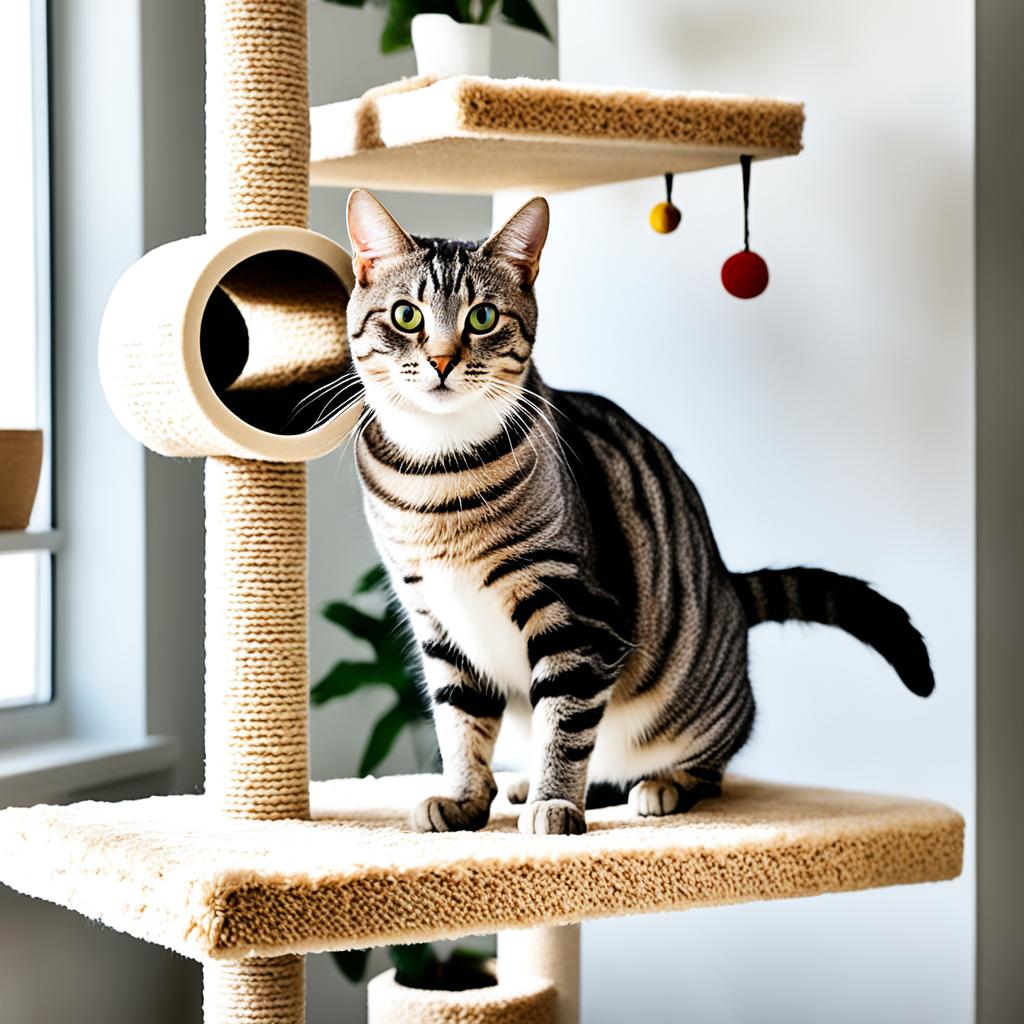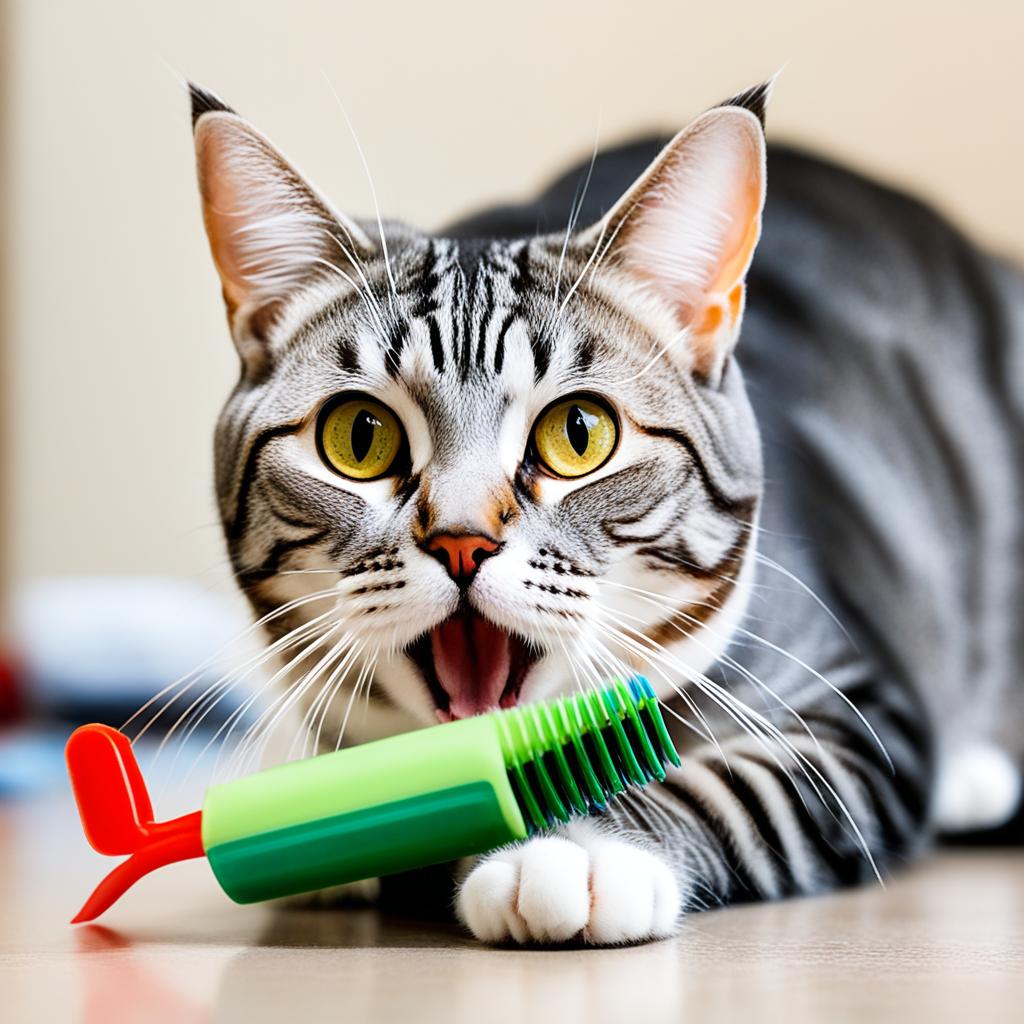Have you ever seen your American Shorthair go from happy to hissing in a second? Some cats might show extra ‘cattitude,’ and it seems their fur color plays a role. A UK study points out that cats with tuxedo and tortoiseshell patterns tend to be more aggressive.
This study talked to cat owners about their pets’ behavior. It found that tuxedo cats can be quite aggressive. Meanwhile, tortoiseshell cats might not be the best with people. Even grey and white cats may dislike the vet. Female calico cats in the US also show similar aggression. Let’s look closer to find out why and how we can help.
Key Takeaways
- Coat patterns may influence aggression levels in American Shorthair cats, with tuxedo and tortoiseshell cats often displaying higher aggression.
- Physical and behavioral indicators are essential in identifying aggression in American Shorthairs.
- Several factors contribute to aggression, including medical issues, environmental stress, and territorial disputes.
- Preventive measures such as early socialization and providing mental and physical stimulation can help minimize aggression.
- Immediate and long-term strategies are crucial in managing and reducing aggressive behaviors in American Shorthair cats.
Understanding American Shorthair Temperament

The American Shorthair cat is known for being friendly and fitting well into homes. They can be loving, but sometimes they might seem a little bold or even unfriendly. It’s key to know them well to live happily with them.
Typical Behavior Traits
People who love cats enjoy the American Shorthair’s typical traits. They are usually calm and can adjust to different homes. Yet, their behavior can be unpredictable at times, showing their wild side. Understand these traits and learn how to handle them, especially how to deal with cat aggression.
The Link Between Coat Color and Temperament
There is a link between the cat’s coat color and its behavior. For example, tuxedo American Shorthairs may sometimes be more aggressive. But remember, each cat is unique, and the link between coat color and behavior isn’t clear-cut. It’s more important to observe your cat closely and understand its personal ways.
Common Signs of Aggression in American Shorthair Cats

It’s important for cat owners to spot aggression in their American Shorthair. Aggression can show up in different physical and behavioral ways. Let’s talk about these key signs.
Physical Signs
American Shorthair cats show they’re aggressive through specific physical signs. Seeing these signs tells you when your cat is scared or annoyed. Look for these physical cues:
- Flattened ears
- Puffed tail
- Hissing
- Swatting
- Biting
Behavioral Indicators
But aggression isn’t just about how your cat looks. It’s also about their actions towards people or other pets. Knowing these behaviors can help you deal with the situation calmly. Look out for these actions:
- Stalking
- Chasing
- Ambushing
Recognizing these aggression signs can stop bigger issues. Learning about your cat’s behavior leads to a happy home for everyone involved.
Causes of Aggression in American Shorthair Cats

Aggression can puzzle pet owners of American Shorthair cats. Many believe it’s because of health problems. Things like pain and sickness can make a cat act out. Also, changes in their home or a dirty litter box can make them grouchy.
American Shorthairs also really care about their space. If they feel another cat is getting too close, they might act aggressively. This happens a lot in homes with more than one cat.
Past bad experiences are another big factor. Cats that have been hurt or ignored might be scared and react by being mean. It’s crucial to figure out why a cat is acting this way. Talking to a vet or a cat expert can help solve these behavior issues in American Shorthair cats.
| Cause | Description | Solution |
|---|---|---|
| Medical Problems | Pain, illness, or discomfort leading to aggressive behavior | Consult a veterinarian |
| Environmental Stress | Changes in household, poor litter box management | Identify and minimize stress factors |
| Territorial Disputes | Competition for space within a multi-cat household | Provide separate areas and resources |
| Past Traumas | History of neglect or abuse resulting in defensive behaviors | Seek professional behaviorist advice |
Preventive Measures to Minimize Aggression

Worried your American Shorthair might act too much like a tiger? It’s key to know how to keep them calm. We’ll share purrfect tips for this.
Early Socialization
Starting early is crucial for dealing with cat aggression. Socialize your American Shorthair from a young age. Let them meet different people, animals, and places. This makes them adaptable and self-assured. It prevents them from becoming too scared and aggressive. So, handling aggression in American Shorthair cats begins with early socialization.
Providing Mental and Physical Stimulation
American Shorthairs are quite bright and need mental and physical workouts. Keep them happy with playtime, puzzle feeders, and some time outside. Staying active is key in dealing with aggression in American Shorthair cats. A cat that’s tired is less likely to be aggressive.
Here are some ways to keep your cat stimulated:
- Interactive toys like laser pointers and feather wands.
- Puzzle feeders that make your cat work for their food.
- Safe outdoor activities such as leash walks or enclosed yard time.
Starting these activities early can be a game-changer. Your American Shorthair will be both calm and happy.
How to Handle Aggression in American Shorthair Cats?

Handling an aggressive American Shorthair can be tough like a cat jungle. But don’t worry! The right steps can calm those wild moments and bring peace.
Immediate Response to Aggressive Behavior
When your Shorthair acts aggressively, stay quick but relaxed. Here’s what to do right away:
- Remove what’s causing the attack.
- Give your cat space to relax.
- Talk to your cat in a soothing way.
De-escalate the problem without rewarding the bad behavior.
Long-Term Strategies
To fix aggression in American Shorthairs, use steady tactics. Here are some ways to help in the long run:
- Keep the environment stable and safe.
- Stick to a daily schedule.
- Try training methods for better behavior.
- Reward good actions with positive feedback.
Always be consistent if you want to understand and curb aggression in your American Shorthair. A set routine and stable setting can make your cat feel less stressed and stop the tantrums.
Training Techniques to Curb Aggression

Make your American Shorthair less ‘sassy’ and more cuddly with the right training techniques for cats. With training, your cat can be a loving companion instead of a troublemaker. Here’s what you can do.
Behavioral Training
Structured behavioral training really works wonders. It means teaching your cat to swap out aggressive actions for better ones. Clicker training is a great example. This method pairs a clicking sound with a treat when your cat behaves well. It teaches your American Shorthair to connect good deeds with rewards.
Positive Reinforcement
Using positive reinforcement can also change your cat’s behavior for the better. It’s about rewarding your cat with treats or love when they behave. Besides easing tips for dealing with cat aggression, this technique deepens the bond between you and your pet. With time, these training sessions will bring harmony into your home. It’s not just about stopping bad behavior. It’s about creating a place of love and cooperation.
Let’s compare these two training methods:
| Training Technique | Effectiveness | Bond Strengthening |
|---|---|---|
| Clicker Training | High | Moderate |
| Reward-Based Training | Moderate | High |
Make these training techniques for cats part of your daily life. With clear rules and steady training, your American Shorthair will turn into a beloved family member.
Understanding Your Cat’s Boundaries and Preferences

Understanding a cat’s space is crucial when you own one. Each cat has its unique likes and dislikes. By knowing cat behavior well, you can build a respectful relationship.
Knowing where your cat’s limits are is important. For example, your American Shorthair may not like being approached in a certain way. Or your cat may prefer a quiet place in your home. Understanding these signs helps prevent issues like cat aggression.
Here are some behaviors you might see and what they mean:
| Behavior | Indication |
|---|---|
| Flattened Ears | Distress or Discomfort |
| Puffed Tail | Fear or Aggression |
| Slow Blinking | Contentment and Trust |
| Averting Eyes | Deference or Anxiety |
| Purring | Comfort (or sometimes pain) |
Respecting cat’s boundaries is key for your cat’s well-being and for preventing aggression. It means giving them their space and not pushing them into interactions. This fosters trust and happiness between you and your cat.
Make sure your cat feels secure in its favorite spots at home. Offer them quiet places when they need to be alone. Being patient and showing respect helps strengthen your bond by honoring their need for personal space.
Managing Aggression Towards Other Pets

Bringing a new friend into your American Shorthair’s life is tricky. You need a careful plan to keep peace.
Introducing a New Pet
Introduce new pets slowly for success. Begin by letting them get used to each other’s smell. Swapping their bedding can work wonders. Then, let them see each other through a gate or partly open door. This way, they can be safe but still meet.
- Scent Swapping: Use different toys or bedding to exchange scents between the pets.
- Gradual Meetings: Start with short, controlled interactions and slowly increase the duration.
- Positive Reinforcement: Reward both pets with treats and praise for calm behavior.
Always watch as they first meet to stop trouble. If things get tense, break them up and try again later.
Environmental Enrichment
Making a home full of fun can cut down on fighting. Try adding things like hiding spots, places to climb, and toys they can play with. This can make them happier and less likely to argue.
Making their home more interesting can reduce stress and improve behavior. Here are some things you can do to enrich your cat’s environment:
| Enrichment Element | Benefits |
|---|---|
| Hideaways | Provide retreats and personal space, reducing stress. |
| Vertical Spaces | Offer climbing opportunities and vantage points to observe surroundings. |
| Interactive Toys | Encourage physical and mental stimulation, diverting aggressive energy. |
| Separate Feeding Areas | Minimize competition and food-related aggression. |
Gradual introductions and enhancing the environment can calm pet aggression. By attending to short-term and long-term needs, your furry friends can live happily together. This helps your American Shorthair enjoy its home with friends.
Handling Aggression Towards Humans

Dealing with American Shorthair cats’ aggression needs us to understand its causes. This way, we can find the best ways to manage it. To do this, it’s important to spot what makes your cat upset. This will help make life better for both of you.
Recognizing Triggers
Understanding what triggers your cat’s aggression is the first step. These triggers could be many things. They might include how they’re picked up or if their personal space suddenly changes. Watching for these signs helps you avoid situations that could turn aggressive.
Effective Handling Techniques
Once you know your cat’s triggers, you can work on better ways to handle them. Focus on creating good moments with your cat and letting them have their own space. Remember, never use physical force. Instead, be gentle and patient. These actions encourage your cat to behave well.
Role of a Veterinarian in Addressing Aggressive Behavior
Your first step in dealing with an aggressive American Shorthair is to team up with a vet. Vets play a key role in tackling cat aggression. They help rule out any health issues causing the problem. Things like dental problems or thyroid issues could be the root cause.
After checking for health problems, your vet will help your cat cool off. They will give you tips and tricks to calm your pet. This might include special sprays, changes in diet, or fun exercises. Changing behaviors often needs many steps, and your vet will guide you each step of the way.
If it’s a tough case, your vet might suggest a meeting with a professional cat behaviorist. These specialists know all about American Shorthair cat problems. They can give you custom advice on how to handle your cat’s aggression. So, your vet is more than a pet doctor. They are your partner in creating a peaceful home for you and your furry friend.




